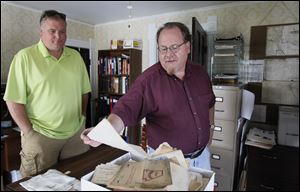
Sylvania houses its past in home frozen in time
Heritage Center Museum preserves town's history
8/20/2012
Ted Long, Sylvania Area Historical Society trustee, left, and Bob Smith, president, sift through documents at the Sylvania Heritage Center Museum. The house was once owned by Dr. Uriah Cooke and his family.
In 1902, Uriah Cooke, a Sylvania doctor and founding member of the Sylvania Savings Bank, decided he needed something bigger.
It took two years of construction to add onto his building and create the facility he wanted, a structure that would house both his family living quarters and his medical office.
Today, Dr. Cooke's house is the site of the Sylvania Heritage Center Museum on Main Street, in the heart of downtown Sylvania. Dr. Cooke died in 1942, but the home remained in his family until 1989. The city of Sylvania purchased the house for its museum in 1992.
PHOTO GALLERY: Sylvania Heritage Center Museum
Some of the house remains caught in the past, although it is used today as the city museum and also as archival offices for the Sylvania Area Historical Society.
Bob Smith, president of the society, knows many of the intricate details of the home -- such as the continued use of a coal-burning fireplace and the doctor's office, with the apothecary and medicine counter intact.
"I've talked to people who were born in this room," Mr. Smith said, gesturing to the exam table. Upstairs, remnants of the past are evident throughout the bedrooms.
"It still has its 1905 wallpaper" in one of the bedrooms, he said.
The historical significance, he said, is in the details. For example, Mr. Smith said some of the floors are done in a technique called featherflocking. "They went around with a white milk paint, and then they would take a feathered brush," he said, adding that it was an economical way to make floors look attractive.
In another room on the second floor, the Toledo Area Miniature Enthusiasts have set up dioramas and doll houses depicting early life in Sylvania and explaining its history. Another room houses maps as well as boxes and filing cabinets full of information about the city awaiting sorting.
With two staircases, one that leads into the entrance area of the house and another that leads to the kitchen, it's easy to imagine that the large house could be a maze.
The intricacies of the structure don't end at the doorway, but continue outside.
"Mr. Cooke had a windmill that would pump water into a cistern so he could have running water in the house," Mr. Smith said. The bottom half the old windmill is still standing, near the Sister City garden, which celebrates Sylvania's sister city of Woodstock, Ontario.
Grave markers found in town and donated to the museum are lined up in the backyard.
The museum is open for tours on Wednesdays from 3 to 7 p.m. and on Saturdays and Sundays from 1-4 p.m. Although it is closed for tours during August, it is to reopen the first week of September.
More information is available at sylvaniahistory.org.